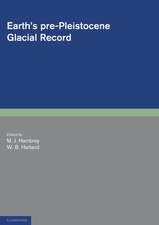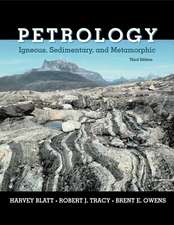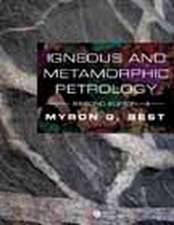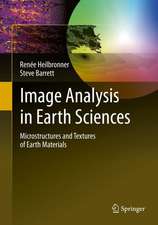Petrology of Lamproites
Autor Roger H. Mitchell, S.C. Bergmanen Limba Engleză Hardback – 29 iun 1991
| Toate formatele și edițiile | Preț | Express |
|---|---|---|
| Paperback (1) | 1015.18 lei 6-8 săpt. | |
| Springer Us – oct 2012 | 1015.18 lei 6-8 săpt. | |
| Hardback (1) | 967.08 lei 6-8 săpt. | |
| Springer Us – 29 iun 1991 | 967.08 lei 6-8 săpt. |
Preț: 967.08 lei
Preț vechi: 1179.37 lei
-18% Nou
Puncte Express: 1451
Preț estimativ în valută:
185.04€ • 194.24$ • 153.59£
185.04€ • 194.24$ • 153.59£
Carte tipărită la comandă
Livrare economică 10-24 aprilie
Preluare comenzi: 021 569.72.76
Specificații
ISBN-13: 9780306435560
ISBN-10: 030643556X
Pagini: 447
Ilustrații: XVI, 447 p.
Dimensiuni: 178 x 254 x 30 mm
Greutate: 1.07 kg
Ediția:1991
Editura: Springer Us
Colecția Springer
Locul publicării:New York, NY, United States
ISBN-10: 030643556X
Pagini: 447
Ilustrații: XVI, 447 p.
Dimensiuni: 178 x 254 x 30 mm
Greutate: 1.07 kg
Ediția:1991
Editura: Springer Us
Colecția Springer
Locul publicării:New York, NY, United States
Public țintă
ResearchDescriere
In this book, the first dedicated entirely to the petrology of lamproites and their relationships to other potassium-rich rocks, the objective of the authors is to provide a comprehensive critical review of the occurrence, mineralogy, geochemistry, and petrogenesis of the clan. Although lamproites represent one of the rarest of all rock types, they are both economically and scientifically important and we believe the time is ripe for a review of the advances made in their petrology over the past two decades. Many of these advances stem from the recognition of diamond-bearing lamproites in Western Australia and the reclassification of several anomalous diamond-bearing kim berlites as lamproites. Consequently lamproites, previously of interest only to a small number of mineralogists specializing in exotica outside the mainstream of igneous petrol ogy, have become prime targets for diamond exploration on a worldwide basis. Contemporaneously with these developments, petrologists realized that lamproites possess isotopic signatures complementary to those of midoceanic ridge basalts, alkali basalts, kimberlites, and other mantle-derived melts. These isotopic studies provided new insights into the long-term development of the mantle by suggesting that the source regions of lamproites were metasomatically enriched in light rare earth and other incompatible elements up to 1-2 Ga prior to the melting events leading to generation of the magma.
Cuprins
1. The Lamproite Clan—Etymology and Historical Perspective.- 1.1. Introduction.- 1.2. Initial Discoveries—1870–1906.- 1.3. Etymology of Lamproite.- 1.4. Western Australian Discoveries—The Legitimization of Lamproites.- 1.5. Johannsen and Modal Classifications of Rocks.- 1.6. Further Developments, New Occurrences, and Diamond-Bearing Lamproites.- 1.7. Reclassification of Anomalous Kimberlites.- 1.8. Recent Developments.- 2. Potassic Rocks and the Lamproite Clan.- 2.1. Alkalinity, Sodic, Potassic, and Ultrapotassic Rocks.- 2.2. Alkali-Alumina Relationships.- 2.3. Potassic Rocks—General Petrographie Characteristics and Terminology.- 2.3.1. Lamproites.- 2.3.2. Roman Province Leucitites.- 2.3.3. Ultrapotassic Leucitites.- 2.3.4. Kalsilite-Bearing Lavas (Kamafugitic Rocks).- 2.3.5. Potassic Lamprophyres.- 2.3.6. Kimberlite and Micaceous Kimberlites.- 2.3.7. The Shoshonite Association.- 2.3.8. Potassic Intrusive Rocks.- 2.4. Petrochemical Classifications of Potassic Rocks.- 2.4.1. Niggli Parameters.- 2.4.2. K2O-Na2O Diagrams.- 2.4.3. Total Alkali-Silica Classifications.- 2.4.4. Sahama (1974).- 2.4.5. Barton (1979).- 2.4.6. Bogatikov et al. (1985).- 2.4.7. Foley et al. (1987).- 2.5. Petrographie and Mineralogical Classifications.- 2.5.1. Petrographie Classifications.- 2.5.2. Mineralogical Classifications.- 2.6. The Lamproite Clan.- 2.6.1. Geochemical Criteria for Lamproite Recognition.- 2.6.2. Mineralogical Criteria for Lamproite Recognition.- 3. Description of Lamproite Occurrences—Distribution, Age, Characteristics, and Geological Framework.- 3.1. Introduction.- 3.2. North American and Greenland Lamproites.- 3.2.1. Group Name: Prairie Creek.- 3.2.2. Group Name: Leucite Hills.- 3.2.3. Group Name: Smoky Butte.- 3.2.4. Group Name: Francis.- 3.2.5. Group Name: Hills Pond.- 3.2.6. Group Name: Sisimiut.- 3.2.7. Group Name: Yellow Water Butte.- 3.2.8. Group Name: Froze-to-Death Butte.- 3.3. European Lamproites.- 3.3.1. Group Name: Murcia-Almeria.- 3.3.2. Group Name: Sisco.- 3.3.3. Group Name: Sesia-Lanzo and Combin.- 3.4. African Lamproites.- 3.4.1. Group Name: Kapamba.- 3.4.2. Group Name: Pneil, Postmasburg, Swartruggens.- 3.4.3. Group Name: Bobi.- 3.5. Australian Lamproites.- 3.5.1. Group Name: Argyle.- 3.5.2. Group Name: West Kimberley.- 3.6. Antarctic Lamproites.- 3.6.1. Group Name: Gaussberg.- 3.6.2. Group Names: Mount Bayliss and Priestley Peak.- 3.7. Asian Lamproites.- 3.7.1. Group Name: Chelima.- 3.7.2. Group Name: Majhgawan.- 3.7.3. Group Name: Barakar.- 3.7.4. Group Name: Murun.- 3.8. South American Lamproites.- 3.8.1. Group Name: Coromandel.- 3.9. Conclusions.- 4. Tectonic Framework of Lamproite Genesis.- 4.1. Age and Temporal Relations of Lamproite Magmatism.- 4.2. Regional Geological and Tectonic Setting Generalizations.- 4.2.1. Lamproites and Plate Tectonics.- 4.2.2. Lamproites and Contemporaneous Subduction Zones.- 4.2.3. Fracture Zones, Transform Faults, and Continental Lineaments.- 4.2.4. Mantle Plumes, Hot Spots, and Hot Regions.- 4.2.5. Continental Rift Zones and Aulacogens.- 4.2.6. Orogeny and Postorogenic Relaxation.- 4.3. Lithospheric History of Lamproite Settings.- 4.3.1. Regional Structure.- 4.3.2. Basement Age, Composition, and Evolution.- 4.3.3. Contemporaneous, Previous, and Subsequent Magmatism.- 4.3.4. Importance of Paleosubduction and Fossil Benioff Zones.- 4.3.5. Mantle Metasomatism—Another Necessary Condition.- 4.3.6. Comparison with Kimberlites, Alkali Basalts, Lamprophyres, and Potassium-Rich Rocks.- 4.4. Tectonic Framework of Four Mesozoic-to-Cenozoic Lamproite Type-Locality Magmatic Fields.- 4.4.1. Leucite Hills.- 4.4.2. West Kimberley.- 4.4.3. Murcia-Almeria.- 4.4.4. Prairie Creek.- 4.5. Conclusions and Preferred Model.- 5. Petrological Facies and Igneous Forms of the Lamproite Clan.- 5.1. Introduction.- 5.1.1. Historical Development.- 5.1.2. Lamproite Igneous Forms.- 5.1.3. Lamproite Facies Classification.- 5.2. Lava Flow Facies.- 5.2.1. Examples of Lava Flow Facies Lamproites.- 5.2.2. Comparisons with Other Mafic and Intermediate Lavas.- 5.2.3. Summary.- 5.3. Crater and Pyroclastic Facies.- 5.3.1. Vent Morphology.- 5.3.2. Pyroclastic Fall Deposits.- 5.3.3. Base Surge and Pyroclastic Flow Deposits.- 5.3.4. Epiclastic Deposits.- 5.3.5. Examples of Crater and Pyroclastic Facies Lamproites.- 5.4. Hypabyssal Facies.- 5.4.1. Examples of Hypabyssal Facies Lamproites.- 5.5. Plutonic Facies.- 5.6. Generalized Model of Eruptive Sequences.- 5.7. Comparison with Kimberlite Diatremes.- 5.8. Summary.- 6. Mineralogy of Lamproites.- 6.1. Phlogopite.- 6.1.1. Paragenesis.- 6.1.2. Leucite Hills, Wyoming.- 6.1.3. West Kimberley, West Australia.- 6.1.4. Argyle, West Australia.- 6.1.5. Prairie Creek, Arkansas.- 6.1.6. Murcia-Almeria, Spain.- 6.1.7. Smoky Butte, Montana.- 6.1.8. Kapamba, Zambia.- 6.1.9. Sisimiut, Greenland.- 6.1.10. Hills Pond—Rose Dome, Kansas.- 6.1.11. Bobi, Ivory Coast.- 6.1.12. Francis, Utah.- 6.1.13. Yellow Water Butte, Montana.- 6.1.14. Sisco, Corsica.- 6.1.15. Majhgawan, India.- 6.1.16. Gaussberg, Antarctica.- 6.1.17. Probable Lamproites—Murun, Presidente Oligario, and Chelima.- 6.1.18. Minor and Trace Elements.- 6.1.19. Summary of Mica Compositional Variations.- 6.1.20. Solid Solutions in Lamproite Mica.- 6.1.21. Comparisons with Mica in Other Potassic Rocks.- 6.1.22. Conditions of Crystallization.- 6.2. Amphibole.- 6.2.1. Classification.- 6.2.2. Paragenesis.- 6.2.3. Composition.- 6.2.4. Minor and Trace Elements.- 6.2.5. Comparisons with Amphiboles in Other Potassic Rocks.- 6.2.6. Conditions of Crystallization.- 6.3. Clinopyroxene.- 6.3.1. Paragenesis.- 6.3.2. Composition of Phenocrystal and Groundmass Pryoxenes.- 6.3.3. Compositions of Pyroxenes from Parageneses 2 and 3.- 6.3.4. Comparison with Pyroxenes in Other Potassic Rocks.- 6.4. Orthopyroxene.- 6.4.1. Paragenesis.- 6.4.2. Composition.- 6.5. Olivine.- 6.5.1. Paragenesis.- 6.5.2. Composition.- 6.5.3. Summary.- 6.6. Leucite.- 6.6.1. Paragenesis.- 6.6.2. Composition.- 6.7. Analcite.- 6.8. Sanidine.- 6.8.1. Paragenesis.- 6.8.2. Composition.- 6.9. Spinel.- 6.9.1. Paragenesis—Primary Spinels.- 6.9.2. Composition—Primary Spinels.- 6.9.3. Comparison with Primary Spinels from Kimberlite and Lamprophyre.- 6.9.4. Secondary Aluminous Spinels.- 6.10. Priderite.- 6.10.1. Paragenesis.- 6.10.2. Composition.- 6.10.3. Ba-Titanates Related to Priderite.- 6.10.4. Comparison with Hollandites in Other Potassic Rocks.- 6.11. Jeppeite.- 6.12. Iron Titanium Oxides.- 6.12.1. Armalcolite.- 6.12.2. Ilmenite.- 6.12.3. Titanium Dioxides.- 6.13. Potassium Zirconium Silicates.- 6.13.1. Wadeite.- 6.13.2. Dalyite.- 6.14. Apatite.- 6.14.1. Paragenesis.- 6.14.2. Composition.- 6.15. Perovskite.- 6.15.1. Paragenesis.- 6.15.2. Composition.- 6.16. Titanosilicates.- 6.16.1. Shcherbakovite.- 6.16.2. Davanite.- 6.16.3. Unnamed K-Ba-Titanosilicate.- 6.17. Minor Accessory and Secondary Minerals.- 6.17.1. Zeolites.- 6.17.2. Carbonates.- 6.17.3. Roedderitelike Phases.- 6.17.4. Cerium-Bearing Minerals.- 6.17.5. Silicon Dioxide.- 6.17.6. Barite.- 6.17.7. Other Minerals.- 6.17.8. Secondary Phases.- 7. The Geochemistry of Lamproites.- 7.1. Major Element Geochemistry.- 7.1.1. General Characteristics.- 7.1.2. Compositional Relationships to Other Potassic Lavas.- 7.1.3. Intraprovincial Characteristics.- 7.2. Compatible Trace Elements.- 7.2.1. First Period Transition Elements.- 7.2.2. Platinum Group Elements.- 7.3. Incompatible Trace Elements—1: Ba?Sr, Zr?Hf, Nb?Ta, Th?U.- 7.3.1. Barium and Strontium.- 7.3.2. Zirconium and Hafnium.- 7.3.3. Niobium and Tantalum.- 7.3.4. Thorium and Uranium.- 7.4. Incompatible Trace Elements—2: Rare Earth Elements and Yttrium.- 7.4.1. Rare Earth Elements.- 7.4.2. Yttrium.- 7.5. Incompatible Trace Elements—3: Alkali Elements.- 7.5.1. Lithium.- 7.5.2. Rubidium.- 7.5.3. Cesium.- 7.6. Volatile Trace Elements: Fluorine, Sulfur, and Chlorine.- 7.7. Other Trace Elements.- 7.8. Interelement Relationships.- 7.9. Isotopic Composition.- 7.9.1. Strontium and Neodymium.- 7.9.2. Lead.- 7.9.3. Oxygen.- 7.10. Summary.- 8. Experimental Studies Relevant to the Formation and Crystallization of Lamproites.- 8.1. Low-Pressure Studies of Lamproites.- 8.1.1. Anhydrous Melting Relationships.- 8.1.2. Water-Saturated Melting Relationships.- 8.2. High-Pressure Phase Relationships of Natural Lamproites.- 8.2.1. Phlogopite Lamproites.- 8.2.2. Olivine and Madupitic Lamproites.- 8.3. Synthetic Systems.- 8.4. The Oxidation State of Lamproite Magmas.- 8.5. Summary.- 9. Diamonds, Xenoliths, and Exploration Techniques.- 9.1. Diamonds and Xenoliths: Alien, Yet Beneficial, Companions of Lamproites.- 9.2. Diamonds.- 9.2.1. Type, Morphology, Color, and Size.- 9.2.2. Mineral Inclusion Suite.- 9.2.3. Isotopic Composition.- 9.2.4. Comparison with Kimberlite Diamonds.- 9.2.5. Discussion.- 9.3. Xenoliths and Xenocrysts.- 9.3.1. Xenoliths in Olivine Lamproites.- 9.3.2. Xenoliths in Leucite and Phlogopite Lamproites.- 9.3.3. Discussion.- 9.4. Exploration Techniques for Diamondiferous Lamproite.- 9.4.1. Remote Sensing Techniques.- 9.4.2. Geophysical Techniques.- 9.4.3. Geochemical Surveys.- 9.4.4. Indicator/Heavy Mineral Sampling.- 9.4.5. Summary.- 10. Petrogenesis of Lamproites.- 10.1. Introduction.- 10.2. Previous Petrogenetic Models.- 10.2.1. Fractionation of Peridotite and Kimberlite.- 10.2.2. Contamination of Kimberlite.- 10.2.3. Partial Melting of Garnet Lherzolite.- 10.2.4. Incongruent Melting of Phlogopite.- 10.2.5. Fractional Fusion and Diapiric Uprise.- 10.2.6. Partial Melting of Enriched Mantle.- 10.2.7. Partial Melting of Harzburgitic Sources.- 10.2.8. Subduction-Related Models.- 10.3. Genesis of the Lamproite Clan.- 10.3.1. Character of the Source.- 10.3.2. Melting of the Source.- 10.3.3. Relationships between Olivine and Phlogopite Lamproites and the Origins of the Isotopic Signatures of the West Kimberley Lamproites.- 10.3.4. Relationship of Madupitic Lamproites to Phlogopite Lamproites and the Origins of Isotopic Signatures of the Leucite Hills Lamproites.- 10.3.5. The Anomalous Murcia-Almeria Lamproites.- 10.4. Relationships to Kimberlites.- 10.5. Relationships to MARID-Suite Xenoliths.- 10.6. Relationships to Other Potassic Rocks and Lamprophyres.- 10.7. Summary.- Postscript.- References.











